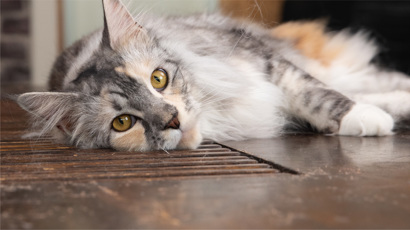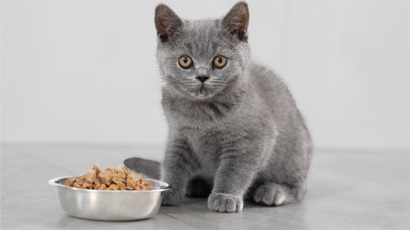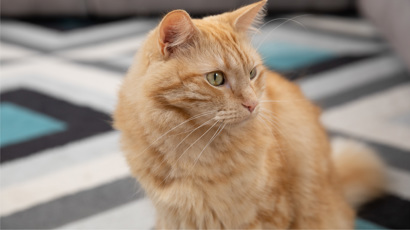Interactive Feeding for your Cat - Cat Toys and More

Feeding your Cat - the Benefits of Interactivity
Cats in the wild tend to make multiple hunting attempts throughout a single day, and only nearly half of those will be successful and lead to a meal. This is reflected in their daily time budgeting - an average cat spends a merely 2% of their 24-hour day eating. However, about 15 to 46% of their day are spent on the ‘hunting’ process, which includes the time for traveling, stalking, and killing.
Many house cats, on the other hand, are kept indoors for safety, health, and ecological reasons. However, the misperception is that cats are low-maintenance pets, meaning indoor only cats often lack opportunities to express their normal hunting and foraging behaviours. Food that is highly palatable and readily available is offered in a bowl in relatively large amounts, either divided into one or two meals a day, or ad libitum. Many cats with outdoor access are also fed similarly by their owners, having easy access to highly palatable food and have not much need to hunt and forage.
Benefits of Interactive Feeding for your Cat
Some challenges you may find with traditional methods of feeding your cat (i.e. feeding from a bowl):
- The lack of the ‘hunting’ process leaves a void in the cat’s ‘time budget’. So how do they fill this void? Possibly by chewing on hair ties, electrical cords, houseplants, or other problematic behaviours.
- When a cat lacks interaction with the environment and receives insufficient mental stimulation, this can lead to stress-related behavioural and mental health problems which can include aggression, house-soiling, over-grooming, and attention-seeking behaviours. Stress is also commonly associated with health issues such as lower urinary tract diseases in cats.
- When experiencing boredom, eating can also become an activity, even in cats with outdoor access. This can easily lead to overconsumption of food, weight gain, and obesity.
What is interactive feeding?
Interactive feeding, as the term itself suggests, meaning ‘action’ from the cat is involved during feeding, usually both physically and mentally. The most common type of interactive feeding is using food puzzles (or feeding toys for cats) when feeding cats. These toys only deliver food when your cat interacts with them, which imitates a cat’s natural foraging and hunting behaviour.
There are two main categories of food puzzles: stationary or rolling (mobile). They can be used to provide either dry or wet food, or both. Many are available commercially, or you can also make them easily at home.
Benefits of using food puzzles
A scientific review* on food puzzles for cats shows that cats may benefit from using puzzle feeders, including:
- Reducing signs of stress
- Improving body condition (weight loss)
- Increase mobility
- Reduce aggression towards people or other cats/animals
- Reduce attention seeking behaviour (such as meowing for food or nocturnal vocalisation)
- Improved relationship with owners
Stationary Food Puzzles for Cat s
s
Stationary food puzzles tend to have a wider base that is designed to stay on a surface. They usually contain holes, cups, wells and/or channels for food to go in. Your cat will need to use their paw to fish out the kibbles, or their tongue and jaws to extract food (especially with wet food).
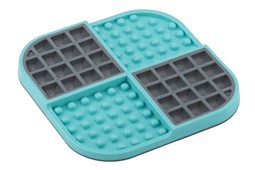
Examples of stationary food puzzles:
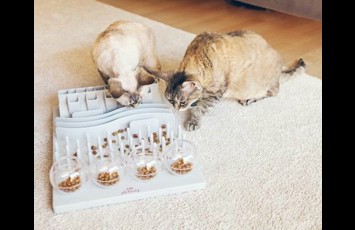
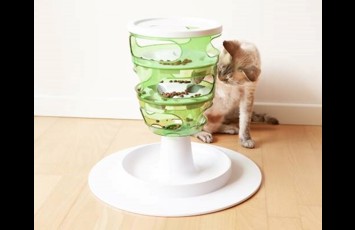
Rolling Puzzle Cat Feeding Toys
A rolling food puzzle is sometimes also called mobile food-dispensing toy, which usually have at least one (often more) hole or opening on their surfaces which is designed for dry kibbles to pass through when your cat rolls the toy with her paw or nose.

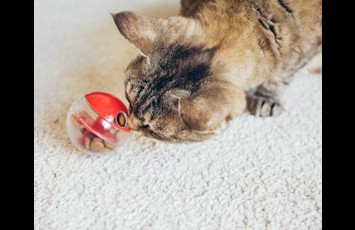
Key Points for Cat Interactive Feeding
- Divide the cat’s daily food allowance into multiple (5 or more), small meals per day to imitate the natural feline time budgeting for hunting, foraging, and eating. You can find your cats daily food allowance on the feeding guidelines on the back of the food packaging.
- When introducing food puzzles to your cat, it is best to be done gradually. Start with feeding toys for cats that are the easiest for your cat to obtain food, so they can warm up to the idea, learn how to use the puzzles, and most importantly, avoid causing frustrations.
- Changing the location of a portion of their food each time can encourage your cat to engage their sense of smell as well as providing them with mental and physical stimulations. Some food-dispensing toys are designed to hold a small number of kibbles to be hidden in different spaces around the house.
More Information on feline interactive feeding and food puzzles are available through the following organisations.
International Society of Feline Medicine (International Cat Care):
American Association of Feline Practitioners (AAFP):
*Dantas LMS, Delgado MM, Johnson I and Buffington CAT. 2016. Food puzzles for cats: feeding for physical and emotional wellbeing. Journal of Feline Medicine and Surgery. 18:723-732.
